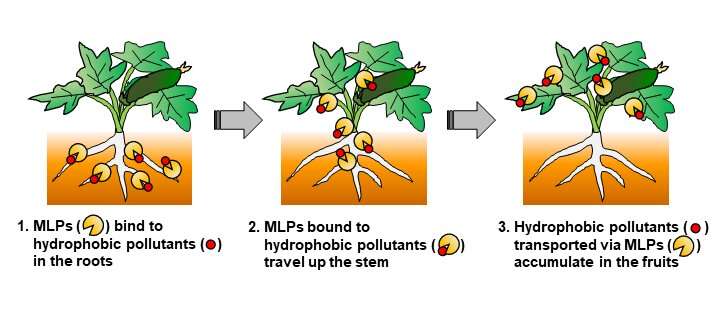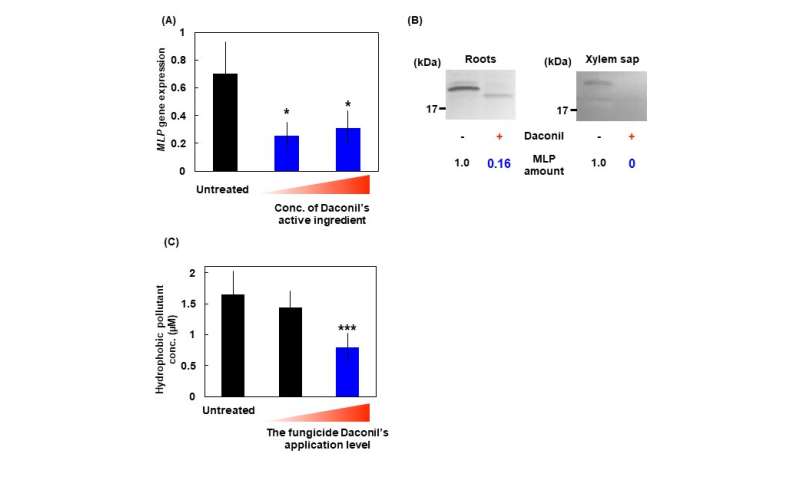#Pesticides can protect crops from hydrophobic pollutants
“#Pesticides can protect crops from hydrophobic pollutants”

Researchers have revealed that commercial pesticides can be applied to crops in the Cucurbitaceae family to decrease their accumulation of hydrophobic pollutants, thereby improving crop safety. The research group consisted of Fujita Kentaro (1st year Ph.D. student) of Kobe University’s Graduate School of Agricultural Science, Academic Researcher Yoshihara Ryouhei (now an assistant professor at Saitama University) and Associate Professor Inui Hideyuki of Kobe University’s Biosignal Research Center, Senior Research Scientist Kondoh Yasumitsu, Technical Staff Honda Kaori and Group Director Osada Hiroyuki of RIKEN, and Lead Researcher Haga Yuki and Senior Scientist Matsumura Chisato of Hyogo Prefectural Institute of Environmental Sciences.
The team developed two approaches to control the functions of plant proteins related to the transport of hydrophobic pollutants. These findings will lead to these new functions of pesticides being utilized in agriculture, enabling safer crops to be produced. These results were published online in the international scientific journal Science of the Total Environment on June 23 and in Environmental Pollution on July 18.
Main Points
- Crops in the Cucurbitaceae family can accumulate hydrophobic pollutants (such as dioxins) in their fruits from contaminated soil. Major latex-like proteins (MLPs) play a key role in transporting hydrophobic pollutants to their fruits.
- Approach 1: Treatment with a pesticide that suppresses the expression of MLP gene decreases the concentrations of hydrophobic pollutants in the xylem sap.
- Approach 2: Treatment with a pesticide that binds to MLPs inhibits the binding of the proteins to hydrophobic pollutants. Thus, the concentrations of hydrophobic pollutants in the xylem sap that were transported via MLPs were reduced.
- It was shown that pesticides could provide a simple and low-cost solution to the production of safer crops.
- This study revealed, for the first time in the world, a new way that pesticides can be used in agriculture, which is different from current methods.
Hydrophobic pollutants include dioxins, the insecticide dieldrin, and endocrine disruptors. These pollutants are highly toxic, and their manufacture and use are now prohibited. However, these substances were used in large quantities up until they were banned, causing widespread environmental pollution that also affects agricultural land.
The Cucurbitaceae family includes crops such as cucumbers and squashes. Members of this family are different from other plant species in that they accumulate high concentrations of hydrophobic pollutants in their fruits. Associate Professor Inui et al. previously discovered that major latex-like proteins (MLPs) in the Cucurbitaceae family play a key role in this accumulation. MLPs bind to hydrophobic pollutants taken up from the soil by the roots of the plant. The Cucurbitaceae family then accumulate hydrophobic pollutants in the leaves and fruits via the sap in the stems (Figure 1). Consequently, MLPs are a major factor that causes crop contamination in the Cucurbitaceae family.
When crops are found to have accumulated hydrophobic pollutants above the residual limit, all crops grown on the same land are unable to be sold, resulting in great economic losses for the producer. For this reason, much research has been conducted into ways to remove hydrophobic pollutants from agricultural soil, however a cost-effective and efficient method has yet to be found. Therefore, there is an urgent need to develop technology for the cultivation of safer crops on arable land contaminated by hydrophobic pollutants.
This study focused on pesticides that have been confirmed to be safe. The researchers tried two approaches designed to suppress the accumulation of hydrophobic pollutants via MLPs: utilizing a ‘pesticide which suppresses MLP gene expression’ and a ‘MLP-binding pesticide.’ They aimed to produce safer cucurbitaceous crops.

Approach 1 (published in Science of the Total Environment)
The application of a pesticide that suppresses MLP gene expression reduces the concentration of MLPs in the roots and xylem sap. This suggested that the concentrations of hydrophobic pollutants accumulated in the fruits via MLP would also be reduced.
First, experiments were carried out to select a pesticide that could suppress MLP gene expression from five types of pesticide used on the Cucurbitaceae family (the insecticides Guardbait, Starkle, and Diazinon and the fungicides Benlate and Daconil). Daconil was chosen because treatment showed that its active ingredient could reduce MLP gene expression. Next, it was confirmed that concentrations of MLPs in the roots and xylem sap of zucchini grown in soil contaminated with hydrophobic pollutants were reduced by the Daconil treatment. Furthermore, the concentrations of hydrophobic pollutants in the xylem sap decreased by 52%.
Approach 2 (published in Environmental Pollution)
The application of MLP-binding pesticide inhibits the binding of MLPs to hydrophobic pollutants in the roots. In other words, the amount of MLPs that binds to the pollutants is reduced. It was hypothesized that this approach would decrease the concentrations of hydrophobic pollutants accumulated in the fruits via MLPs.
First of all, chemical arrays with approximately 22,000 compounds from the RIKEN NPDepo were used to identify compounds that bound to MLPs. The insecticide Colt that can be applied to crops in the Cucurbitaceae family was selected from commercial pesticides with similar structures to MLP-binding compounds. When Colt’s active ingredient was reacted with both MLPs and the hydrophobic pollutants, the concentration of MLPs bound to these pollutants decreased by 78%. In addition, the concentrations of these pollutants in the xylem sap fell by 15% after Colt treatment.
Further Research
This study revealed, for the first time in the world, that it is possible to cultivate safer crops in contaminated soil through the control of the plant’s functions. This achievement could reduce the number of cases where producers experience economic losses due to being unable to sell crops grown in contaminated soil. Furthermore, this will also provide consumers with safe produce.
A new method of utilizing pesticides has been revealed by this research. For the first time in the world, this study has revealed a novel aspect of pesticides beyond their original functions of preventing pests or weed growth. Pesticides are thought to be extremely safe because they have to pass numerous strict safety tests. Furthermore, the standardized treatment of crops with pesticides is simple and inexpensive. Therefore, it is anticipated that the method developed by this study to reduce hydrophobic pollutants using pesticides will become widespread across the globe.
More information:
Kentaro Fujita et al, Suppression of the genes responsible for transporting hydrophobic pollutants leads to the production of safer crops, Science of The Total Environment (2020). DOI: 10.1016/j.scitotenv.2020.140439
Pesticides can protect crops from hydrophobic pollutants (2020, July 28)
retrieved 28 July 2020
from https://phys.org/news/2020-07-pesticides-crops-hydrophobic-pollutants.html
This document is subject to copyright. Apart from any fair dealing for the purpose of private study or research, no
part may be reproduced without the written permission. The content is provided for information purposes only.
If you want to read more Like this articles, you can visit our Science category.
if you want to watch Movies or Tv Shows go to Dizi.BuradaBiliyorum.Com for forums sites go to Forum.BuradaBiliyorum.Com



